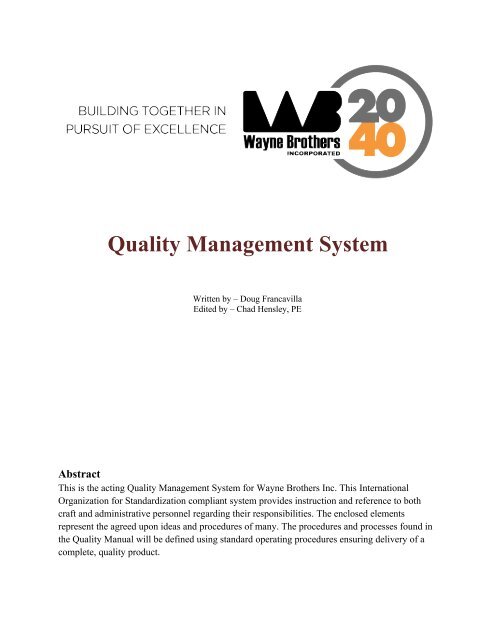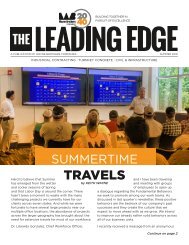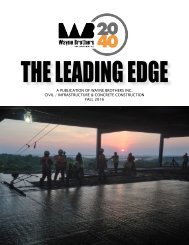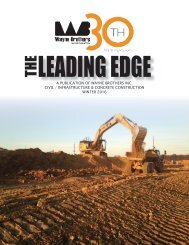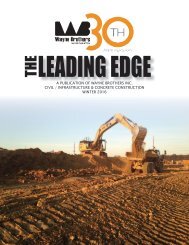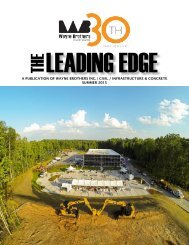WBI Quality Management System
Create successful ePaper yourself
Turn your PDF publications into a flip-book with our unique Google optimized e-Paper software.
<strong>Quality</strong> <strong>Management</strong> <strong>System</strong><br />
Written by – Doug Francavilla<br />
Edited by – Chad Hensley, PE<br />
Abstract<br />
This is the acting <strong>Quality</strong> <strong>Management</strong> <strong>System</strong> for Wayne Brothers Inc. This International<br />
Organization for Standardization compliant system provides instruction and reference to both<br />
craft and administrative personnel regarding their responsibilities. The enclosed elements<br />
represent the agreed upon ideas and procedures of many. The procedures and processes found in<br />
the <strong>Quality</strong> Manual will be defined using standard operating procedures ensuring delivery of a<br />
complete, quality product.
Table of Contents<br />
Abstract ........................................................................................................................................................1<br />
Introduction ..................................................................................................................................................4<br />
Clause 1: Scope ............................................................................................................................................5<br />
Clause 2: Normative References ..................................................................................................................5<br />
Clause 3: Terms and Definitions ..................................................................................................................5<br />
Clause 4: Context of the Organization..........................................................................................................6<br />
4.1 Understanding the Organization and its Context ................................................................................6<br />
4.2 Understanding the Needs and Expectations of Interested Parties .......................................................6<br />
4.3 Determination of the Scope of the <strong>Quality</strong> <strong>Management</strong> <strong>System</strong> .......................................................6<br />
4.4 <strong>Quality</strong> <strong>Management</strong> <strong>System</strong> Associated Processes ...........................................................................6<br />
Clause 5: Leadership ....................................................................................................................................7<br />
5.1 Leadership and Commitment..............................................................................................................7<br />
5.2 <strong>Quality</strong> Policy.....................................................................................................................................7<br />
5.3 Organizational Roles, Responsibilities, and Authorities.....................................................................8<br />
Clause 6: Planning........................................................................................................................................8<br />
6.1 Actions to Address Risk and Opportunity ..........................................................................................8<br />
6.2 <strong>Quality</strong> Objectives and Planning to Achieve Them............................................................................8<br />
6.3 Planning of Changes...........................................................................................................................9<br />
Clause 7: Support .........................................................................................................................................9<br />
7.1 Resources............................................................................................................................................9<br />
7.2 Competence ........................................................................................................................................9<br />
7.3 Awareness...........................................................................................................................................9<br />
7.4 Communication ................................................................................................................................10<br />
7.5 Documented Information..................................................................................................................10<br />
7.6 Document Control ............................................................................................................................10<br />
Clause 8: Operation ....................................................................................................................................10<br />
8.1 Operational Planning and Control ....................................................................................................10<br />
8.2 Customer Communication ................................................................................................................10<br />
8.3 Development of Products and Services ............................................................................................11<br />
8.4 Control of Externally Provided Processes, Products, and Services ..................................................11<br />
8.5 Production and Service Controls ......................................................................................................11
8.6 Release of Products and Service.......................................................................................................12<br />
8.7 Control of Non-conforming Products and Services ..........................................................................12<br />
Clause 9: Performance Evaluation..............................................................................................................12<br />
9.1 Monitoring, Measurement, Analysis, and Evaluation.......................................................................12<br />
9.2 Internal Audits ..................................................................................................................................12<br />
9.3 <strong>Management</strong> Review ........................................................................................................................13<br />
Clause 10: Improvement.............................................................................................................................13<br />
10.1 General ...........................................................................................................................................13<br />
10.2 Nonconformity and Corrective Action ...........................................................................................13<br />
10.3 Continual Improvement ..................................................................................................................13
Introduction<br />
This document, in its entirety, can be considered the written First Edition of the <strong>Quality</strong><br />
<strong>Management</strong> <strong>System</strong>. The <strong>Quality</strong> <strong>Management</strong> <strong>System</strong> (QMS) has been specifically created for<br />
all employees of Wayne Brothers, Inc. (<strong>WBI</strong>). Company policy, objectives, activities, evaluation<br />
criteria among other topics are addressed in this document. The <strong>Quality</strong> Manual (QM) is one<br />
constituent of the QMS. The <strong>Quality</strong> Manual explains, in detail, the tasks that will be handled by<br />
employees of <strong>WBI</strong> and contracted affiliates ranging from those in field positions to those in<br />
administrative roles. The system has been modeled in such a way that is International<br />
Organization for Standardization (ISO) compliant with the current 9001:2015 standard which<br />
compliments the level of professionalism, quality, and completeness which Wayne Brothers<br />
performs its services. The principles in this manual should be recognized as a foundation to<br />
guide and improve performance and quality.<br />
The <strong>Quality</strong> Manual is to continuously improve the quality of Wayne Brothers’ work. It will<br />
help, guide, and teach all employees to produce work in a competent, efficient, and consistent<br />
manner. The <strong>Quality</strong> Manual will serve as a source of reference highlighting important items and<br />
using images and tables as aids for comprehension all with clear and easy navigation throughout.<br />
All topics covered in the QM are followed by standard operating procedures which have been<br />
written based on decades of experience. The manual includes specific information regarding<br />
manpower, equipment needs, material and material quantities, tools that will be required for<br />
individual tasks and more. <strong>WBI</strong> provides classroom and hands on training for all levels of field<br />
employees in order to provide uniform knowledge and practices to all involved in the<br />
constructing of projects to achieve <strong>WBI</strong> standards and exceed customer expectations.<br />
Throughout the manual you will find activity descriptions and defined procedures used to<br />
develop all employees regardless of status or position. These procedures will align with the<br />
direction and expectations of our Superintendents and the content of our Training Program. Our<br />
employees will be responsible and accountable for work performed across a broad range of<br />
activities.<br />
It is our goal to include and address all aspects of the business. Should scope change or an<br />
omission be discovered within the document, it will be updated to reflect the change. Without a<br />
doubt there will be continual evaluations of the content which will lead to modifications in<br />
pursuit of continual improvement of the manual and system. The manual shall always serve as<br />
our most up to date guide offering the latest standards thereby helping <strong>WBI</strong> improve its<br />
production of work year after year.
Clause 1: Scope<br />
This document serves as the <strong>Quality</strong> <strong>Management</strong> <strong>System</strong> (QMS) developed specifically for<br />
Wayne Brothers, Inc. (<strong>WBI</strong>). Included in the QMS is a <strong>Quality</strong> Manual with standard operating<br />
procedures required for planning and executing Wayne Brothers business processes including<br />
but not limited to the following: site development operations, concrete operations, human<br />
resources, accounting, and other support operations. One goal of the current QMS is to identify<br />
and integrate various internal processes into a single approach per task for consistent<br />
performance and results that stem from proven practices. Through standardizing and<br />
streamlining our business, we will be able to identify, measure, control, and improve every<br />
aspect of work. This will lead to continual improvement and growth necessary for <strong>WBI</strong> to<br />
achieve its long term goal: “TO BECOME THE #1 CONSTRUCTION SERVICES TEAM.”<br />
The QMS defines the individual team member responsibilities by job title. Inspection processes,<br />
checklists, as-built surveys, non-conformance reporting and follow up process improvements are<br />
all within the scope of this document.<br />
Clause 2: Normative References<br />
The following documents are referenced and indispensable in the execution of our QMS: our<br />
contract documents including contracts, project drawings and specifications, documents<br />
incorporated by reference including building codes, American Concrete Institute specifications,<br />
Concrete Reinforcing Steel Institute specifications, and product manufacturer guidelines. The<br />
aforementioned documents are common normative references. National Center for Construction<br />
Education and Research documents, <strong>WBI</strong> training manuals, American Society of Concrete<br />
Contractor publications, and National Ready Mixed Concrete Association publications may also<br />
be considered normative references. Standards and guidelines like those found in professional<br />
documents throughout are referenced and linked to their full form. The latest editions of the<br />
referenced documents are used. The terms and definitions that are not explicitly defined within<br />
this document are given in ISO 9001:2008 and ISO 9001:2015.<br />
Clause 3: Terms and Definitions<br />
For the entirety of this document, the terms and definitions found in ISO 9001:2015 apply.
Clause 4: Context of the Organization<br />
4.1 Understanding the Organization and its Context<br />
<strong>WBI</strong> Executive <strong>Management</strong> identifies internal and external issues that impact <strong>WBI</strong>’s reputation,<br />
productivity, financial success and strategic direction. Determining and identifying issues<br />
directly affects the ability of the company and employees to achieve the intended results of the<br />
QMS. <strong>Quality</strong> objectives are developed when quality issues are identified. <strong>Quality</strong> objectives<br />
define the purpose of the QMS.<br />
4.2 Understanding the Needs and Expectations of Interested Parties<br />
Project specific <strong>Quality</strong> Manuals will be produced to support <strong>WBI</strong> activities specific to each<br />
individual project. Each QM will be designed to address: the scope of the contracted work, the<br />
known expectations of the client based on contract language and held conversations, and how the<br />
QM relates to the overall system. Understanding the requirements of the client allows <strong>WBI</strong> to<br />
form a proactive approach to operations and client relations. It is a tangible plan when delivered<br />
to the client demonstrating transparency and clarifying expectations before the work commences.<br />
Any issues the client raises can be addressed and resolved in a proactive fashion.<br />
In addition to <strong>WBI</strong> clients, the Executive <strong>Management</strong> Team, Board of Directors, and <strong>WBI</strong><br />
Shareholders are also included as interested parties. The interest of these parties lies in the desire<br />
for continuous improvement of the enterprise, increased efficiency of the operations and staff,<br />
increased market share, enhanced reputation, and increased value of the company.<br />
4.3 Determination of the Scope of the <strong>Quality</strong> <strong>Management</strong> <strong>System</strong><br />
The scope of the QMS was developed to support the strategic direction of <strong>WBI</strong> as an<br />
organization. Internal and external issues, associated and interested parties, overall services<br />
offered were also considered. Services range from expansive superflat concrete floors to cast-inplace<br />
shored slabs and civil and infrastructure services to turnkey concrete projects. The QMS is<br />
expected to become an essential tool that is available to all <strong>WBI</strong> employees. The scope also<br />
should be recognized as being relevant to field operations and administrative/business<br />
operations.<br />
4.4 <strong>Quality</strong> <strong>Management</strong> <strong>System</strong> Associated Processes<br />
<strong>WBI</strong> has established a number of standard operating procedures (SOPs) to aid employees in the<br />
completion of tasks. Currently, the majority of the SOPs focus on field activities that are<br />
performed by craft employees. Procedures include information regarding manpower allocation,<br />
expected production rates, tools and material needed, best practice instructions, safety concerns,<br />
and helpful tips for employees to pay special attention to. Procedures addressing other areas of<br />
the business are being developed. All SOPs are reviewed by executive management prior to<br />
inclusion into the <strong>Quality</strong> Manual for quality assurance purposes. Processes will be evaluated<br />
during practice and any worthy changes will be implemented in order to achieve the best results.
Changes will only occur after a review of proposed changes is accepted by executive<br />
management.<br />
Clause 5: Leadership<br />
5.1 Leadership and Commitment<br />
Executive management shall be involved in many areas of the QMS serving as guiding and<br />
enforcing leaders. It is important for management to review recommendations from employees to<br />
assess for alignment with the scope of the QMS and the strategic direction of <strong>WBI</strong>. This review<br />
shall include policies, objectives, procedures, effectiveness, commitment, accountability and<br />
more. <strong>Management</strong> is to demonstrate leadership serving as the beginning point of<br />
communicating the importance of an effective QMS to others and enforcing its use with provided<br />
resources in order to achieve its intended results.<br />
Executive management has reviewed the company quality policy and believes in its purpose.<br />
When implemented, this quality policy will support the future growth of <strong>WBI</strong> by framing quality<br />
objectives and making them visible for all interested parties.<br />
5.2 <strong>Quality</strong> Policy<br />
Through standardizing and streamlining business practices across all disciplines, Wayne<br />
Brothers, Inc. will be able to continue to safely exceed expectations while following a trajectory<br />
“To Become the #1 Construction Services Team.”<br />
This will be achieved through:<br />
- Established quality objectives and defined employee responsibilities<br />
- Identifying processes that can be taught in a single and consistent manner to achieve<br />
regular performances<br />
- Measuring, controlling, and improving actions and procedures<br />
- Reducing non-conformance occurrences through the use of best practices and training<br />
- Communicating with clients and employees to receive feedback on the <strong>WBI</strong> <strong>Quality</strong><br />
<strong>Management</strong> <strong>System</strong> while providing competency, empowerment, and accountability<br />
- Active support of management through its implementation<br />
- Maintaining a system that is ISO compliant<br />
It will remain critical to always reflect on the above when any action is taken or any decision is<br />
to be made. Over time with growth and support Wayne Brothers, Inc. will continue to evolve as a<br />
sought after company by clients and employees alike due to its reputation for complete<br />
excellence.
5.3 Organizational Roles, Responsibilities, and Authorities<br />
Organizational roles and responsibilities associated with this QMS are assigned to appropriate<br />
job descriptions. These assignments can be found in the Job Description folder under the Human<br />
Resources drive. Team members also ensure processes deliver their intended results, maintain<br />
and report on the execution of the QMS in practice, and always promote customer focus and<br />
quality improvement.<br />
Clause 6: Planning<br />
6.1 Actions to Address Risk and Opportunity<br />
<strong>WBI</strong> risks and opportunities shall be addressed when evaluating internal and external<br />
circumstances for each project or situation. Site specific <strong>Quality</strong> Manuals shall be written to<br />
address circumstances on each project. Standard Operating Procedures shall be implemented in<br />
ways to most effectively address risks and opportunities.<br />
6.2 <strong>Quality</strong> Objectives and Planning to Achieve Them<br />
Wayne Brother’s objective in risk management is to utilize the resources at its disposal to<br />
effectively capitalize on opportunities and minimize its risk exposure. This is considered as SOPs<br />
are written and reviewed. Employees are encouraged to provide constructive feedback on SOPs<br />
to highlight any inefficiency that takes away from the effectiveness of production activities. This<br />
will help <strong>WBI</strong> resolve any internal or external issues leading to greater control over its processes.<br />
More control leads to increased consistency thereby limiting occurrences of deviation and nonconformance.<br />
The current <strong>Quality</strong> Objectives of <strong>WBI</strong> are found below:<br />
- Develop a <strong>Quality</strong> <strong>Management</strong> <strong>System</strong> by mid-year that will determine root causes of<br />
repair work or rework in the field. This shall include procedures that will lead to<br />
decreased occurrence of errors initiating the rework and repair work<br />
- Promote communication between employees regarding documented SOPs and other<br />
preferred but undocumented procedures in order to ensure that SOPs published are<br />
essential, current and practical<br />
- Design site specific manuals that will be available to <strong>WBI</strong> personnel for reference. The<br />
site specific manuals shall include related inspection forms which are to be completed for<br />
100% of the applicable activities<br />
- Share daily work plans and objectives with craft employees. Daily planning with<br />
employees will promote employee engagement and allow each employee to understand<br />
their work and responsibilities rather than proceeding through motions<br />
- Develop a forum to collect, review and analyze all input from employees to improve the<br />
existing QMS and QM
- Create a system to collect and organize data from field operations, analyze trends, assign<br />
responsibilities, develop improvement measures, and evaluate employees related to<br />
quality<br />
6.3 Planning of Changes<br />
Changes to the QMS and QM will be implemented by updating relevant documents to reflect the<br />
decisions made by management. A communication notice will be sent out to all office personnel<br />
and employees holding a supervisory role after any updates are published. Department leaders<br />
and field supervisors will communicate changes as necessary to their crews based on their roles.<br />
Clause 7: Support<br />
7.1 Resources<br />
Wayne Brothers has appointed a <strong>Quality</strong> Manager to oversee the QMS and QMs. The <strong>Quality</strong><br />
Manager requests the resources needed for the implementation, performance, and improvement<br />
of the QMS. Both internal and external needs are considered and addressed as needed.<br />
Executive <strong>Management</strong> will review and approve the requested resources at their discretion.<br />
<strong>WBI</strong> will determine and require participation by the necessary personnel for effective execution<br />
of the QMS at all levels. Personnel responsible for tasks of the QMS will utilize the available<br />
resources to perform their assigned duties.<br />
<strong>WBI</strong> takes advantage of systems and databases that keep track of the location of resources that<br />
have been distributed for operation needs. This includes people, mobile equipment, tools,<br />
technology devices, vehicles, and more.<br />
7.2 Competence<br />
Employee competence is imperative when identifying personnel for assignment; <strong>WBI</strong> uses past<br />
performance, skill, knowledge, and training classes to help catalogue employees. QR codes will<br />
be used to retrieve employee information including classification, training certifications, and<br />
other pertinent Human Resource information.<br />
7.3 Awareness<br />
All persons performing any procedural activity will have knowledge of and access to the<br />
associated SOP. Any person performing work under <strong>WBI</strong> control will be aware of the Policy and<br />
Objectives which will help them to personally understand the importance of their contribution to<br />
the task as well as the QMS. Each employee or subcontractor will understand the ramifications<br />
of disregarding any SOP.
7.4 Communication<br />
<strong>WBI</strong> has established chains of communication relevant to the QMS and its components.<br />
Communication procedures have been defined including when to communicate, who<br />
communicates, with whom to communicate, means of communication, and what will be<br />
communicated.<br />
7.5 Documented Information<br />
All required documents have been included as required by ISO 9001:2015. Additional<br />
documentation is created when necessary as determined by the <strong>Quality</strong> Manager and <strong>WBI</strong><br />
management.<br />
7.6 Document Control<br />
Active quality management documents shall follow a uniform naming system to aid in clarity<br />
without the need to open the document. File tree systems are to be intuitive to easily find and<br />
place documents. Documents that are classified as private will be locked to prevent unauthorized<br />
changes, improper use, or the loss of integrity. All active QMS and QM documents will be<br />
reviewed at least once annually in order to keep current. Edits will produce a newer version<br />
reflecting changes and improvements in the process and the QMS. Obsolete documents will be<br />
deleted.<br />
<strong>WBI</strong> will maintain operational/project documentation for any changes that deviate from the<br />
specified contract documents or distributed drawings. Formal RFIs, change orders, received<br />
verbal instructions, etc. will be transcribed and retained in writing to document and control<br />
changes to work.<br />
Clause 8: Operation<br />
8.1 Operational Planning and Control<br />
<strong>WBI</strong> defines operational planning processes and control measures that are conducted as standard<br />
practice in conjunction with clauses 4-7. <strong>WBI</strong> management, supervision and the <strong>Quality</strong><br />
Manager will determine when additional planning processes and control measures are necessary<br />
to ensure the desired quality is achieved.<br />
8.2 Customer Communication<br />
Customer communication begins with knowledge of past experiences, if any. Notes should be<br />
retrieved which include any processes specific to the particular client, preferences, tendencies,<br />
and more. It is necessary to recognize any requirements stated in contract documents in order to<br />
prepare an estimate, site specific quality manual, etc. Ongoing communication should be natural<br />
during the course of the project. Communication also includes an as-built survey or feedback
elating to completed work and services. All created and received documentation is retained as<br />
applicable for review, referencing, comparison, etc.<br />
8.3 Development of Products and Services<br />
<strong>WBI</strong> has established a QMS which includes maintained SOPs to ensure planning processes are<br />
consistent. <strong>WBI</strong> will follow applicable requirements, the project scope, applicable codes,<br />
regulatory requirements, and all other requirements considered necessary from relatable past<br />
experiences. <strong>WBI</strong> will make every effort to provide the most attentive and considerate proposal<br />
for its service. <strong>WBI</strong> also ensures that it has the ability to meet all stated requirements as well<br />
being able to adapt to changes in scope. It is the intent of <strong>WBI</strong> to adapt to changes in scope to<br />
provide resources necessary to perform the work accordingly.<br />
Methods and control measures are developed to ensure that services and work activities are:<br />
clearly defined; outputs and results are directly related to inputs and expectations; inspections of<br />
processes are conducted as needed; actions are taken; documentation retained.<br />
The final products delivered and services completed will meet the requirements stated in the<br />
contract documents.<br />
As mentioned in the previous section, <strong>WBI</strong> management will retain documentation created<br />
and/or submitted regarding methods, results, reviews, feedback, etc. Changes to established<br />
procedures will be implemented as necessary by the <strong>Quality</strong> Manager and <strong>WBI</strong> management.<br />
8.4 Control of Externally Provided Processes, Products, and Services<br />
<strong>WBI</strong> will provide all external partners with appropriate project contract information including<br />
but not limited to schedules, volumes, weights, addresses, general scope and references to<br />
appropriate codes and standards. <strong>WBI</strong> will also provide external partners with company<br />
expectations upfront. Selection of subcontractors and vendors will be based on the merits of past<br />
working relationships, capacity versus job requirements, distributing location versus job location,<br />
price, etc. Supplier evaluation will be kept to update notes on each particular supplier.<br />
8.5 Production and Service Controls<br />
<strong>WBI</strong> will apply SOPs and processes consistent with client/project requirements and expectations.<br />
Reviews and verification tools will be completed to verify work is proceeding according to the<br />
contract documents and the QMS. Non-conformance reports (NCRs) will be completed and<br />
logged. Appropriate action will be taken as a result of the verification activities.<br />
With regard to procurement of materials, vendors will be analyzed and rated based on their<br />
quality of materials and service, value as a team member, cost of materials, etc. Data should be<br />
continuously collected and retained for quick reference in order to identify performance<br />
indicators and trends for optimal decision making.
<strong>WBI</strong> will be responsible and accountable for all rental equipment while being used by <strong>WBI</strong><br />
employees or during the entire rental term. Measures will be taken to safeguard the<br />
material/equipment from damage or theft. If the material/equipment is lost, damaged or found to<br />
be unsuitable for use, notification will be given to the provider and to <strong>WBI</strong> asset management.<br />
8.6 Release of Products and Service<br />
At appropriate stages (foundation ready for concrete, turn-over process, etc.), responsible <strong>WBI</strong><br />
employees will verify that the latest requirements have been met and will communicate progress<br />
to the client or supervisor. <strong>WBI</strong> will release possession and responsibility for areas of work as<br />
necessary to allow activities by other trades to proceed. This release will transpire with approval<br />
from the client or supervising entity. Documentation of release and approval shall be retained.<br />
8.7 Control of Non-conforming Products and Services<br />
Non-conforming products will be identified, documented, and corrected if possible to prevent the<br />
introduction of any unsatisfactory elements into the work. This also applies to external services<br />
such as delivery of materials and equipment to a job site. A root cause analysis should be<br />
executed when errors are made in the field that result in repairs or rework.<br />
Clause 9: Performance Evaluation<br />
9.1 Monitoring, Measurement, Analysis, and Evaluation<br />
<strong>WBI</strong> <strong>Quality</strong> Manager will determine the circumstances and frequency that monitoring and<br />
measurements should take place for various activities. The observations taken may affect the<br />
frequency of future monitoring. For instance, when poor performance is observed, the frequency<br />
of the future monitoring should be increased. Conversely, if excellent performance is observed,<br />
the frequency may be decreased. <strong>WBI</strong> will retain documentation of the observations for future<br />
reference. Observations of poor performance in any area are unacceptable and must be addressed<br />
by the project team. An evaluation shall be conducted to determine the cause of poor<br />
performance when necessary and corrective measures shall be taken to improve the results.<br />
In keeping with the quality policy and scope of the QMS, the satisfaction of <strong>WBI</strong> customers is<br />
paramount to the success of the company. <strong>WBI</strong> will constantly monitor customer satisfaction<br />
ensuring needs are fulfilled and all reasonable expectations are met. <strong>WBI</strong> will determine<br />
customer satisfaction levels through communication, surveys, reviewing past information, and<br />
more.<br />
9.2 Internal Audits<br />
Internal audits will be planned and conducted at intervals as needed to provide insight on the<br />
targeted sections of the QMS. Audits will conform to ISO 9001:2015 standards while following<br />
the QMS and SOPs. The conclusions drawn from the internal audit may result in changes to the
established processes including reporting, correcting, or maintaining. Audit documentation will<br />
be retained for evidence and note referencing.<br />
9.3 <strong>Management</strong> Review<br />
<strong>WBI</strong> <strong>Quality</strong> Manager will periodically analyze information received from monitoring,<br />
verifications, communications, and reports. It will be the responsibility of all <strong>WBI</strong> employees to<br />
monitor the effectiveness of the QMS. When opportunities for improvement are discovered by<br />
any <strong>WBI</strong> employee it will be the duty of the employee to report the opportunity for improvement<br />
so that an improvement evaluation process is initiated. In order to evaluate compliance with the<br />
QMS and QM, areas for improvement will be assessed including customer satisfaction, adequacy<br />
of resources, and effectiveness of the QMS, internal and external performances.<br />
Clause 10: Improvement<br />
10.1 General<br />
Opportunities for improvement will be considered and implemented in all areas of the QMS as<br />
deemed necessary including but not limited to:<br />
- Improving services to meet contract requirements, meet client expectations, and address<br />
the future trends of the industry<br />
- Correcting, preventing, or reducing undesirable results<br />
- Improving the effectiveness of the <strong>Quality</strong> <strong>Management</strong> <strong>System</strong><br />
- Re-writing standard operating procedures to produce improved results<br />
10.2 Nonconformity and Corrective Action<br />
Non-conforming work includes work that does not meet or exceed the requirements of the<br />
contract. Wayne Brother’s protocol for addressing non-conforming work is as follows:<br />
- Complete the root cause analysis procedure<br />
- Plan corrective action<br />
- Review and document the effectiveness of corrective action<br />
- Update standard operating procedures to reduce the probability of non-conforming work<br />
- Update the QMS as needed<br />
Documentation will be retained for evidence and note referencing.<br />
10.3 Continual Improvement<br />
Wayne Brothers will continually improve its <strong>Quality</strong> <strong>Management</strong> <strong>System</strong> thereby continually<br />
improving the work it performs for its clients. All employees are encouraged to contribute to the<br />
company’s continuous improvement by being accountable for its evolution. Developing<br />
proactive solutions that improve our processes is everyone’s responsibility. New ideas are<br />
always encouraged and assured to be evaluated for their merit. When new ideas are proven to be
an improvement to Wayne Brothers efficiency and/or quality and the results outweigh the cost of<br />
the effort, Wayne Brothers is committed to adopting the changes.


